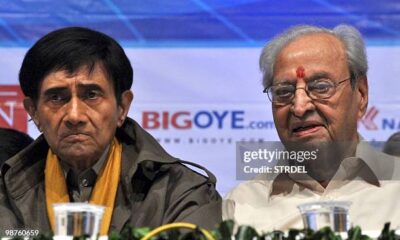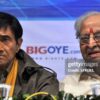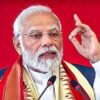Nepal PM Pushpa Kamal Dahal recounts his 4-day India visit stupefying
Nepal PM Pushpa Kamal Dahal recounts his 4-day India visit stupefying
Nepal PM Pushpa Kamal Dahal aka ‘Prachanda’, recounts his 4-day India visit stupefying
Nepal Prime Minister Pushpa Kamal Dahal aka ‘Prachanda’, on his arrival at Kathmandu, recounted his four-day visit to India “stupefying”.
While interacting with media persons upon his arrival at Tribhuwan International Airport in Kathmandu, PM said, he fulfilled his promises he made prior to his departure to India.
In the midst of his meeting and subsequent discussions between him and PM Modi,
myriad of agreements of long-term importance was inked which, in itself, is significant. As for long term power-sharing agreement, the supply of 10,000 MW of electricity over 10 years is something that we have pressed for long, he feels happy that they could arrive at a deal during his visit.
PModi himself made the announcement and the signing of the power-sharing deal marks an important milestone in our bilateral ties.”
He further added that the agreement will help Nepal draw big-ticket investments in the energy sector. The Nepalese PM also emphasised the potential for significant investments in the country’s energy sector in light of this agreement.
During the briefing, the Nepal PM Prachanda also cited ongoing projects such as the 900 MW Arun III being implemented by the Indian company Sutlej in Sankhuwasabha, as well as the Lower Arun project, which has been entrusted to the same company.
Prachanda underscored the newfound trust and foundation established through the power trade agreement, adding that it will enable the landlocked Himalayan country to meet the demands of the private sector.
He also stated that this agreement has further enabled Nepal to export 1,200 MW of electricity to India, generated from the Upper Tamakoshi Hydropower Project.
Furthermore, the Nepalese PM also claimed to have eradicated the mistrust in bilateral relations between the two countries.
PM Modi emphasised on Nepal-India relations in that it should be higher than the Himalayas. PM Modi referred to his visit in 2014 when he addressed the parliament, marking an exciting new chapter in our bilateral ties. He even called the events that he graced during his visit a hit. Now, we should work towards making our relations superhit,” the Nepalese PM added.
Nepal, in 2020, amended its constitution to incorporate a new political and administrative map in the preamble. The new map included the tri-junction of Limpiyadhura, Kalapani and Lipulekh, which are seen as disputed areas.
Nepal’s updated map incorporating the disputed territories was submitted to the Ministry of Land Management by the Department of Survey, claiming that it was based on accurate scale, projection and coordinate system. It was publicly released on May 20, 2020 after a go-ahead from the Cabinet on May 18 of the same year.
The department cited a map drawn during the Treaty of Sugauli and another brought from London, as well as receipts of land revenues payments and the order issued by the then Prime Minister, Chandra Shumsher, as evidence to claim that the disputed territories belong to Nepal.
The earlier map issued in 2032 BS had left out Gunji, Nabhi and Kuri villages. However, they were included in the revised map, adding 335 square kilometres of land.
Tensions escalated between New Delhi and Kathmandu last year over the issuance of the revised map including the tri-junction, which India earlier had included in its map issued in November 2019.
Invoking the difficult phase in the bilateral ties in 2019, Prachanda stated, “The relationship between Nepal and India back in 2019 was mired in difficulties. However, the trade and transit treaty, which was signed (during his visit to New Delhi) has ensured added benefits for Nepal for over two decades. So, it shouldn’t be seen as a small agreement. The trade deficit and smooth cross-border trade were the focus areas during the deliberations, along with the promotion of agricultural goods and facilitation of customs. Hence, it could be said that my visit will help build an environment of trust between the two countries.”
India’s development assistance to Nepal features a broad-based programme focusing on creating infrastructure at the grass-roots level. Various projects have been implemented in areas of infrastructure, health, water resources, education and rural and community development.
Two important integrated checks — at Birgunj and Biratnagar — have been built with Indian assistance. India has built several hydroelectric projects in Nepal including Pokhara (1 MW), Trisuli (21 MW), Western Gandak (15 MW), Devighat (14.1 MW) etc. Agreements have been signed between Satluj Jal Vidyut Nigam (SJVN) Ltd and the Nepal Electricity Authority (NEA) for the development and implementation of the 490.2 MW Arun-4 hydropower project.
The project is expected to generate electricity for Nepal, India as well as Bangladesh. The SJVN has a 51 per cent stake in the project while the NEA has a 49 per cent share. Nepal has also extended an invitation to Indian businesses to invest in the West Seti Hydropower Project.
India and Nepal have robust cooperation in the power sector. Three cross-border transmission lines were completed recently with India’s assistance — 400 kV Muzaffarpur-Dhalkebar line (2016); 132 kV Kataiya-Kusaha and Raxaul-Parwanipur line (2017).
News input KV Raman
















